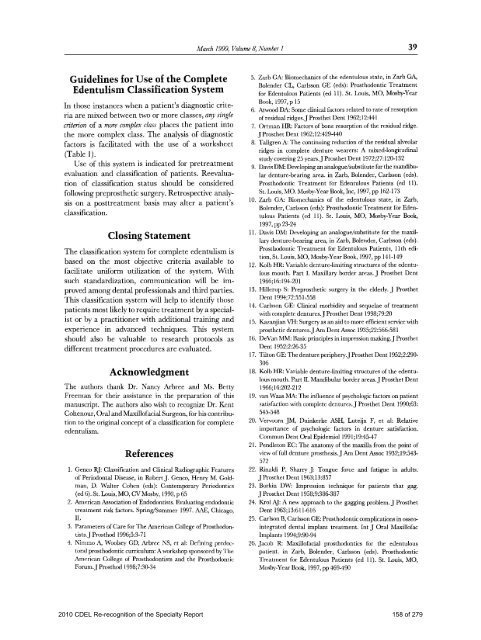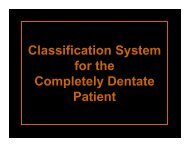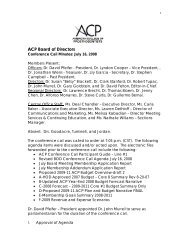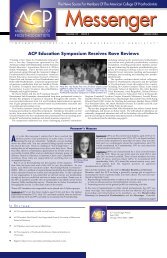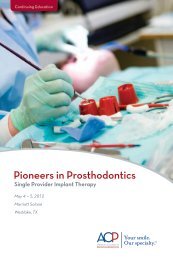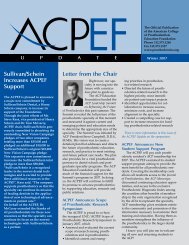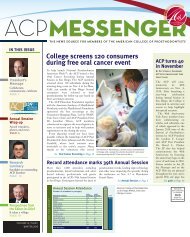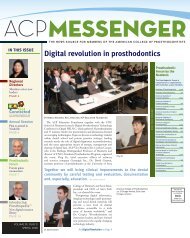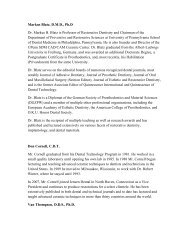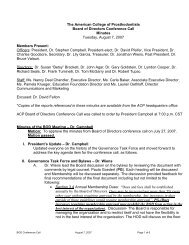PROSTHODONTICS - American College of Prosthodontists
PROSTHODONTICS - American College of Prosthodontists
PROSTHODONTICS - American College of Prosthodontists
Create successful ePaper yourself
Turn your PDF publications into a flip-book with our unique Google optimized e-Paper software.
Murch 1999, Volume 8, Number I 39Guidelines for Use <strong>of</strong> the CompleteEdentulism Classification SystemIn those instances when a patient’s diagnostic crileriaare mixed between two or more classes, any singlecriterion <strong>of</strong> a more compt?ex clm places the patient intothe mnre complex class. The analysis <strong>of</strong> diagnosticfactors is facilitated with the use <strong>of</strong> a worksheet(Table 1).Use <strong>of</strong> this system is indicated for pretreatmentevaluation and classification <strong>of</strong> patients. Reevaluation<strong>of</strong> classification status should be consideredfollowing prcprosthetic surgery. Retrospective analysison a posttreatment basis may alter a patient’sclassification.Closing StatementThe classification system for complete edentulism isbased on the most objective criteria available t<strong>of</strong>acilitate uniform utilization <strong>of</strong> the system. Withsuch standardization, communication will be improvedamong dental pr<strong>of</strong>essionals and third parties.This classification system will help to identify thosepatients most likely to require treatment by a spccialistor by a practitioner with additional training andexperience in advanced techniques. This systemshould also be valuable to research protocols asdifferent treatment proccdures are evaluated.AcknowledgmentThe authors thank Dr. Nancy Arbree and Ms. BrttyFreeman for their assistance in the preparation <strong>of</strong> thismanuscript. The authors also wish to recognize Dr. KentCohenour, Oral and Maxill<strong>of</strong>acial Surgeon, for his contributionto the original concept <strong>of</strong> a classification for completeedentulism.ReferencesGenco RJ: Classification and Clinical Radiographic Features<strong>of</strong> Periodontal Disease, in Robert J. Cenco, Henry M. Goldman,D. Walter Cohen (eds): Contemporary Periodontics(ed 6). St. Louis, MO, CliMosby, 1990, p 65<strong>American</strong> Association <strong>of</strong> Endodontists. Evaluating endcdontictreatment risk factors. Spring/Summer 1997. AAE, Chicago,ILParameters <strong>of</strong> Care for The <strong>American</strong> <strong>College</strong> <strong>of</strong> <strong>Prosthodontists</strong>.J Prosthod 1996;5:3-71Nimmo A, Wwlsey GD, Arbree NS, et al: Defining predoctoralprosthodontic curriculum: A workshop sponsnrcd by TheAmmican <strong>College</strong> <strong>of</strong> <strong>Prosthodontists</strong> and the ProsthodonticForum. J Prosthod 1998;7:30-345. Zarb GA Biomechanics <strong>of</strong> the edentulous state, in Zarb GA,Bolender CL, Carlsson GE (eds): Prosthodontic Treatmentfor Edentulous Patients (ed 11). St. Louis, MO, Mosby-YearBook, 1997,p 156. Atwood DA Some clinical factors related to rate <strong>of</strong> resorption<strong>of</strong>residual ridges. J Prosthet Dent 1962;12:4417. Ortman HR: Factors <strong>of</strong> bone resorption <strong>of</strong> the residual ridge.JProsthet Dent 1962;12:429408. Tallgren A The continuing reduction <strong>of</strong> the residual alveolarridges in complete denture wearers: h mixed-longitudinalstudy covering 25 years. J Prosthet Dent 1972;27:120-1329. Davis DM Developing an analoguehbstitute for the mandibulardenture-bearing area. in Zarb, Bolender, Carlsson (eds).Prosthodontic Treatment for Edentulous Patients (ed 11).St. Louis, MO. h4osby-Year Book, Inc, 1997, pp 162-17310. Zarb GA: Biomechanics <strong>of</strong> the edentulous state, in Zarb,Bolender, Carlsson (eds): Prosthodontic Treatment for EdentulousPatients (ed 11). St. Louis, MO, Mosby-Year Book,1997, pp 23-2411. Davis DhC Developing an analoguehbstitute for the maxillarydenture-bearing area, in Zarb, Bolender, Carlsson (eds).Prosthodontic Treatment for Edentulous Patients, 11 th edition,St. Louis,MO, Mosby-Year Book, 1997, pp 141-14912. Kolb Hk Variable denture-limiting structures <strong>of</strong> the edentulousmouth. Part I. hIaxillary border arras. J Prosthet Dent1966; 16: 194-20113. Hillerup S: Preprosthetic surgery in the elderly. J ProsthetDent 1994;72:.551-55814. Carlsson GE: Clinical morbidity and sequelae <strong>of</strong> treatmentwith complete dentures. J Prosthet Dent 1998;79:2015. Kazanjian VH: Surgery as an aid to more efficient service withprosthetic dentures. JAm Dent Assoc 1935;22:566-58116. DeVan h&k Basic principles in impression making. J ProsthetDent 1952;2:26-3517. Tilton GE: The denture periphery. JProsthet Dent 1952;2:290-30618. Kolb HR Variable denture-limiting structures <strong>of</strong> the edeutubusmouth. Part 11. Mandibular border areas. J Prosthet Dent1966;ifi:2n2-21219. van Waas MA: The influence <strong>of</strong>psychologic factors on patientsatisfaction with complete dentures. J Prosthet Dent 1990;63:545-54820. Vervoorn Jhl, Duinkerke ASH, Luteijn F, et al: Relativeimportance <strong>of</strong> psychologic factors in denture satisfaction.Commun Dent Oral Epidemiol 1991;1945-4721. Pendleton EC: The anatomy <strong>of</strong> the maxilla from the point <strong>of</strong>view <strong>of</strong> full denture prosthesis.J Am Dent Assoc 1932;19:543-57222. Kinaldi P, Sharry J: Tongue force and fatigue in adults.J Prosthet Dent 1963;13:85723. Borkin UW Impression technique for patients that gag.JProsthet Dent 1958;9386-38724. Krol AJ: A new approach to the gagging problem. J ProsthetDent 1963;13:611-61625. Carlson B, CarlssonGE: Prosthodontic complications inosseointegrateddental implant treatment. Int J Oral Maxill<strong>of</strong>acImplants 1994;9:90-9426. .Jamb R Mixill<strong>of</strong>acid prosthodontics for the edentulouspatient. in Zarb, Bolender, Carlsson (eds). ProsthodonticTreatment for Edentulous Patients (ed 11). St. Louis, MO,Mohy-Year Book, 1997, pp 469-4902010 CDEL Re-recognition <strong>of</strong> the Specialty Report 158 <strong>of</strong> 279


